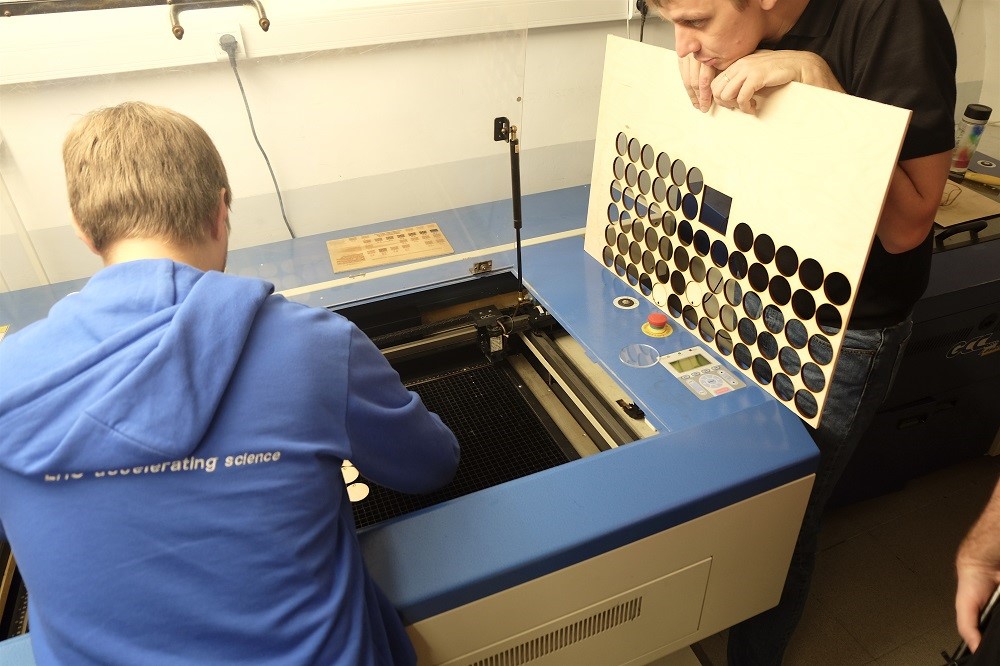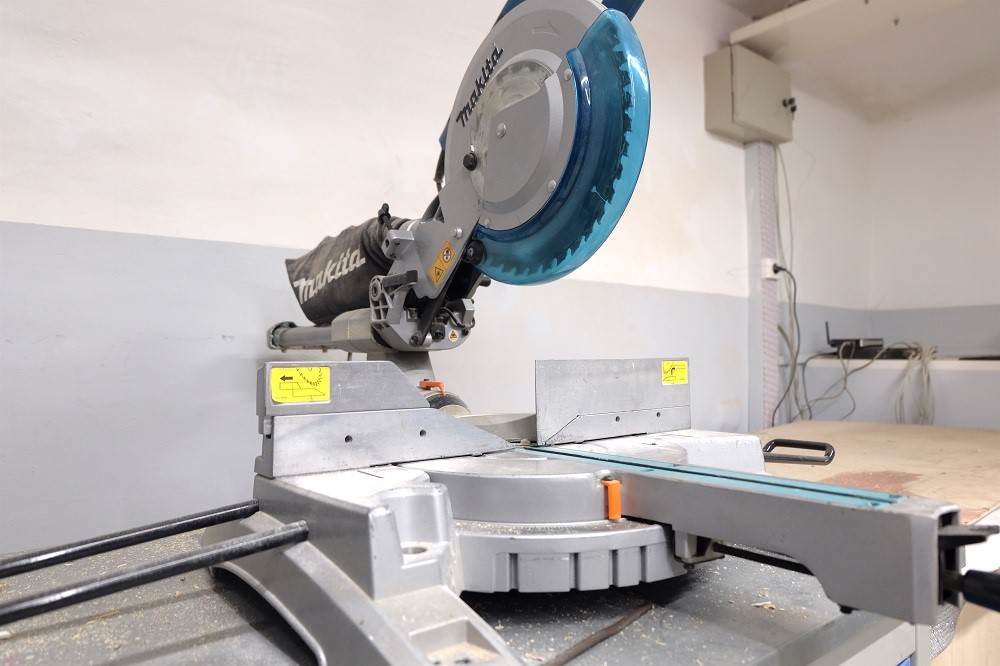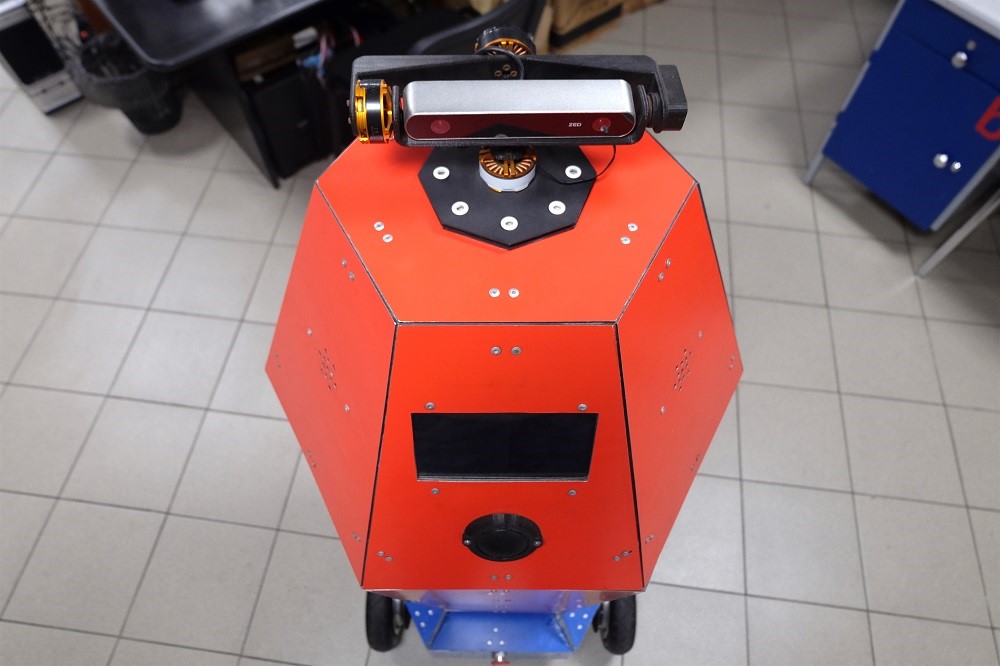FabLab University ITMO: DIY-coworking for creative people - show what's inside
We tell and show what students do in the fablab of the ITMO University . All who are interested in the topic of DIY as part of student initiatives, we invite under the cat.

FabLab University ITMO is a small workshop in which students and teachers of our university can independently create various parts for scientific research or experiments. The idea to create a workshop was filed by Alexey Shchekoldin and Yevgeny Anfimov .
They were engaged in the development of creative DIY projects at home or in the labs of other universities. But the guys felt that it would be nice to implement their ideas within the walls of their own high school. The initiative was presented to the rector of the ITMO University. He supported her.
At the time of the emergence of the ideas of the laboratory, Alexey and Eugene were finishing up their fourth year of undergraduate studies. When they switched to the first magistracy course, the lab lab opened doors for everyone.
FabLab was “launched” in 2015 at the ITMO University Technopark building as part of the 5/100 program , which aims to increase the competitiveness of Russian universities on the world stage. The premises were equipped with places for working on a computer, as well as delimited zones with machines and other equipment.
The goal of the university workshop is to “lure” people with projects, help them put their ideas into practice, and, possibly, establish a startup. The workshop conducts master classes on working with equipment, programming and TRIZ.
Before purchasing the equipment, the university management interviewed students and staff of ITMO University which tools would be most useful in the workshop. So in our fablab appeared MakerBot 3D printers, GCC laser engravers and Roland MDX40 milling machine, as well as soldering stations. Gradually, the laboratory overgrown with new equipment, and now it is possible to find almost any tool for work.

In the photo: MakerBot 3D printer.
In the laboratory there are printing devices assembled from DIY kits.

In the photo: DIY printer created on the basis of open source developments.
Many printers and other equipment are refined by students on their own, creating new equipment and accessories. For example, the printers in the next photo were collected from a set of RepRap. It is part of an initiative to create self-copying devices.

In the photo: DIY printers created on the basis of Open Source developments.
Also in the fab lab there is a UV printer and laser engravers GCC Hybrid MG380 and GCC Spirit LS40, as well as various CNC milling machines.

In the photo: Roland LEF-12 UV printer.

In the photo: GCC Hybrid MG380 laser engraver
There is also a drilling machine, a circular saw and a hand-held power tool: drills, screwdrivers, and hacksaws. There is almost any power tool that must be in the workshop of any maker. The fablab even has a string for cutting polystyrene foam, which is very helpful when modeling from foam.

In the photo: Miter saw Makita LS1018L
Also in the laboratory there are several personal computers where students are engaged in drawing, 3D modeling and programming. Now the fablab has more than 30 items of equipment and tools.

In the photo: “Fablab's computer class”
Students make 3D-models, burn logos on the boards, design art objects. Here everyone can work on a personal project, for example, print a figure of a favorite film character, assemble a milling machine, a quadcopter or an author's guitar. The laboratory devices, unlike the "home" tools, help to realize the idea quickly, with a high level of accuracy.
During the first year of the fab lab, a system was developed for organizing a microclimate in the Evapolar room. The project went to the crowdfunding platform Indiegogo and even raised the target amount. Also on the basis of the laboratory appeared the project “Keyboards for the blind” and the FlashStep solution was born - an embedded system of automated decorative lighting.
FlashStep was developed by the co-founder of the laboratory, Evgeny Anfimov. This is a system for illuminating the stairs of multi-storey country cottages. The idea even managed to monetize - it is in demand from the owners of "smart" homes.
It is also worth highlighting the prototype of the SMARR robot, which works on the basis of VR and AR technologies.

In the photo: SMARR robot
The development of the robot was carried out for two years under the guidance of the founder and head of the laboratory, Shchekoldin Alexey. Ten ITMO University students took part in its creation. They were assisted by university professors, in particular, Sergey Alekseyevich Kolyubin, an associate professor in the department of control systems and robotics, took on the role of the project scientific manager.
Man manages SMARR with the help of Oculus Rift virtual reality glasses. In addition to the pictures from the robot's video camera, the user receives information (for example, tables with any data), which is molded by augmented reality technology. In this case, the robot is able to navigate in unfamiliar places, using probabilistic methods for building a map of the room.
In the future, the authors of SMARR plan to sell the robot. One of the possible areas of its application is working in hazardous conditions, for example, on oil rigs. This will reduce the risks to workers when conducting any assessment activities. Developers also see the potential use of their brainchild in tourism. With the help of a robot, people will be able to go on a virtual journey. For example, on large museums.

In the photo: SMARR robot.
A startup 3dprinterforkids settled in the fab lab. Its founder - Stanislav Pimenov - teaches children 3D-modeling skills, instills in them an interest in robotics.
To provide workshop visitors with more technological tools, we study the needs of other laboratories at our university. At the same time, there are plans to turn the fab lab into a small startup accelerator with a DIY bias. We also want to organize more workshops and excursions for schoolchildren, and more often carry out practical exercises for adults.
News from the life of our laboratory: VK , Facebook , Telegram and Instagram .
About what else we tell on Habré:

How did the fab lab appear
FabLab University ITMO is a small workshop in which students and teachers of our university can independently create various parts for scientific research or experiments. The idea to create a workshop was filed by Alexey Shchekoldin and Yevgeny Anfimov .
They were engaged in the development of creative DIY projects at home or in the labs of other universities. But the guys felt that it would be nice to implement their ideas within the walls of their own high school. The initiative was presented to the rector of the ITMO University. He supported her.
At the time of the emergence of the ideas of the laboratory, Alexey and Eugene were finishing up their fourth year of undergraduate studies. When they switched to the first magistracy course, the lab lab opened doors for everyone.
FabLab was “launched” in 2015 at the ITMO University Technopark building as part of the 5/100 program , which aims to increase the competitiveness of Russian universities on the world stage. The premises were equipped with places for working on a computer, as well as delimited zones with machines and other equipment.
ITMO University students can visit the laboratory and use the equipment for free. Such an approach allowed attracting a large number of students and turning the workshop into a kind of coworking in which you can share experiences, ideas and put them into practice.
The goal of the university workshop is to “lure” people with projects, help them put their ideas into practice, and, possibly, establish a startup. The workshop conducts master classes on working with equipment, programming and TRIZ.
Workshop equipment
Before purchasing the equipment, the university management interviewed students and staff of ITMO University which tools would be most useful in the workshop. So in our fablab appeared MakerBot 3D printers, GCC laser engravers and Roland MDX40 milling machine, as well as soldering stations. Gradually, the laboratory overgrown with new equipment, and now it is possible to find almost any tool for work.

In the photo: MakerBot 3D printer.
In the laboratory there are printing devices assembled from DIY kits.

In the photo: DIY printer created on the basis of open source developments.
Many printers and other equipment are refined by students on their own, creating new equipment and accessories. For example, the printers in the next photo were collected from a set of RepRap. It is part of an initiative to create self-copying devices.

In the photo: DIY printers created on the basis of Open Source developments.
Also in the fab lab there is a UV printer and laser engravers GCC Hybrid MG380 and GCC Spirit LS40, as well as various CNC milling machines.

In the photo: Roland LEF-12 UV printer.

In the photo: GCC Hybrid MG380 laser engraver
There is also a drilling machine, a circular saw and a hand-held power tool: drills, screwdrivers, and hacksaws. There is almost any power tool that must be in the workshop of any maker. The fablab even has a string for cutting polystyrene foam, which is very helpful when modeling from foam.

In the photo: Miter saw Makita LS1018L
Also in the laboratory there are several personal computers where students are engaged in drawing, 3D modeling and programming. Now the fablab has more than 30 items of equipment and tools.

In the photo: “Fablab's computer class”
Himself inventor
Students make 3D-models, burn logos on the boards, design art objects. Here everyone can work on a personal project, for example, print a figure of a favorite film character, assemble a milling machine, a quadcopter or an author's guitar. The laboratory devices, unlike the "home" tools, help to realize the idea quickly, with a high level of accuracy.
The “products” of the workshop-laboratory are regularly shown at exhibitions and festivals. For example, in July VK Fest showed figures printed on a 3D printer. But in the workshop they make not only art objects and projects for the soul. Students implement in the laboratory and high-tech solutions.
During the first year of the fab lab, a system was developed for organizing a microclimate in the Evapolar room. The project went to the crowdfunding platform Indiegogo and even raised the target amount. Also on the basis of the laboratory appeared the project “Keyboards for the blind” and the FlashStep solution was born - an embedded system of automated decorative lighting.
FlashStep was developed by the co-founder of the laboratory, Evgeny Anfimov. This is a system for illuminating the stairs of multi-storey country cottages. The idea even managed to monetize - it is in demand from the owners of "smart" homes.
It is also worth highlighting the prototype of the SMARR robot, which works on the basis of VR and AR technologies.

In the photo: SMARR robot
The development of the robot was carried out for two years under the guidance of the founder and head of the laboratory, Shchekoldin Alexey. Ten ITMO University students took part in its creation. They were assisted by university professors, in particular, Sergey Alekseyevich Kolyubin, an associate professor in the department of control systems and robotics, took on the role of the project scientific manager.
Man manages SMARR with the help of Oculus Rift virtual reality glasses. In addition to the pictures from the robot's video camera, the user receives information (for example, tables with any data), which is molded by augmented reality technology. In this case, the robot is able to navigate in unfamiliar places, using probabilistic methods for building a map of the room.
In the future, the authors of SMARR plan to sell the robot. One of the possible areas of its application is working in hazardous conditions, for example, on oil rigs. This will reduce the risks to workers when conducting any assessment activities. Developers also see the potential use of their brainchild in tourism. With the help of a robot, people will be able to go on a virtual journey. For example, on large museums.

In the photo: SMARR robot.
A startup 3dprinterforkids settled in the fab lab. Its founder - Stanislav Pimenov - teaches children 3D-modeling skills, instills in them an interest in robotics.
What's next
To provide workshop visitors with more technological tools, we study the needs of other laboratories at our university. At the same time, there are plans to turn the fab lab into a small startup accelerator with a DIY bias. We also want to organize more workshops and excursions for schoolchildren, and more often carry out practical exercises for adults.
News from the life of our laboratory: VK , Facebook , Telegram and Instagram .
About what else we tell on Habré:
